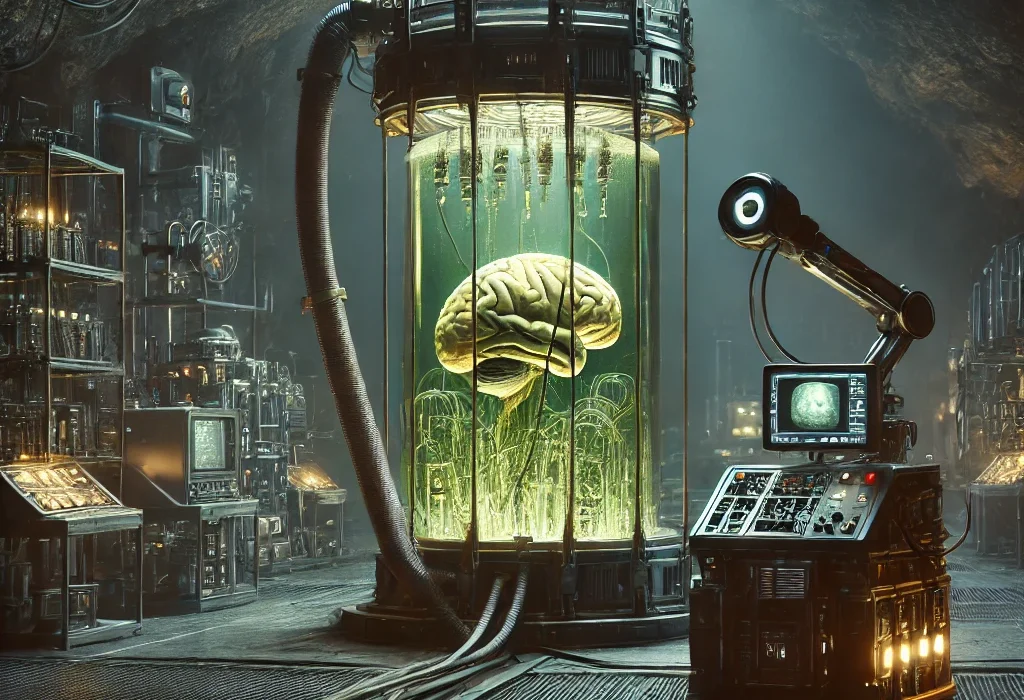All in the Mind by Gene L. Henderson, first published in 1954, is a science fiction short story that delves into themes of identity, the human mind, and the ethical implications of scientific experimentation. This work explores the chilling consequences of brain preservation and consciousness after death, presenting a nightmarish scenario where a scientist’s brain is preserved in a lab, leading to profound realizations about human consciousness, control, and power.
Plot Summary
Mel Carlson drifted in and out of consciousness, his mind floating in a void, enveloped by an overwhelming darkness. Pain throbbed through his brain, as fragmented memories slowly came back. The lab, hidden deep in the mountains—he and Neil had built it there to pursue experiments far from prying eyes. The last thing he remembered was their heated argument. Neil had wanted to push their research further, to experiment on a human brain. But Mel had resisted. It was too dangerous, too unethical. They had done enough with animals. They couldn’t cross that line.
Yet now, something was wrong. He couldn’t move. His limbs didn’t respond, no matter how hard he tried. Panic surged as Mel realized he couldn’t even open his eyes. He struggled to recall what had happened after that argument, but the pain in his head made it impossible to think clearly.
Voices filtered in from the darkness, faint and distorted. He recognized one of them—Neil. He tried to speak, to ask what was happening, but no sound came. His mind screamed, but nothing emerged. Then Neil’s voice cut through, clearer now. Neil was talking to him, explaining something. Slowly, Mel pieced together the horrific truth: his body was gone, but his brain remained alive, floating in a tank. Neil had done it. He had taken Mel’s brain and preserved it, just like they had done with animals.
Time passed in a blur of pain and confusion. Mel drifted in and out of consciousness, his thoughts sluggish and fragmented. Neil’s voice would return, speaking to him, explaining the success of the experiment. Mel’s brain was functioning perfectly, and Neil saw it as a triumph of their research. But for Mel, it was a nightmare. He was trapped, a prisoner in his own mind, with no escape.
Slowly, the reality of his situation set in. He had no body, no voice, and no control over his fate. But his mind was alive—sharper than it had ever been. He began to test his limits, realizing that while he was physically helpless, his brain still held power. He could sense things around him, control the machines that surrounded his tank. Little by little, Mel’s mental abilities grew. He could operate the lab equipment, control a mechanical arm attached to his tank, and even manipulate electrical currents. His mind, unburdened by the limitations of a body, began to expand in ways he hadn’t thought possible.
But as his powers grew, so did his hatred for Neil. His former partner treated him like a tool, using Mel’s intelligence to solve scientific problems and profit from the solutions. Neil opened a consulting service, bringing in increasingly complex problems for Mel to tackle, all while growing rich from the results. Mel’s mind was forced into servitude, and the more Neil profited, the more determined Mel became to break free.
Neil, blinded by his own ambition, never suspected that Mel was planning his revenge. In the silence of the lab, Mel perfected his mental abilities. He learned to control the machines more deftly, to manipulate the electrical systems with precision. Using his newfound powers, he secretly constructed a weapon, an electrical device mounted on the mechanical cart that held his brain. It could fire a lethal beam of electricity, a tool Mel hoped would one day free him from Neil’s control.
As the months wore on, Neil’s plans became more sinister. He hinted at moving the lab, possibly even destroying Mel to cover his tracks. The partnership had served its purpose, but now Neil wanted complete control. Mel knew he had little time left. Neil had always been ruthless, and it was only a matter of time before he decided to get rid of Mel once and for all.
One day, Neil entered the lab with Jenkins, the assistant who had been helping him. Jenkins looked nervous, as if he knew something terrible was about to happen. Mel, who had been watching through the mechanical eye on his cart, sensed the moment was near. He forced Jenkins to replace a fuse that had disabled the cart, allowing him to regain full control of his movements. But just as Jenkins completed the task, Neil entered, his eyes narrowing as he saw the cart moving.
Without hesitation, Neil drew a revolver from his coat. Two quick shots echoed through the lab, and Jenkins collapsed, blood spilling onto the floor. Neil turned the gun on Mel’s tank. A third shot rang out, and Mel felt a jolt of pain as the bullet pierced the glass, causing the life-sustaining fluid to leak out. Panic surged through Mel’s brain as his survival became precarious. But before Neil could finish him off, Mel activated the electrical weapon he had built. A bright, crackling beam shot out from the cart, striking Neil with lethal force. Neil’s body convulsed violently before collapsing into a lifeless heap.
The immediate danger was over, but Mel knew his time was running out. The tank was damaged, and the fluid that kept him alive was rapidly draining. Using the cart’s mechanical arm, he plugged the hole with a piece of wood, buying himself precious time. The automatic systems in the lab began replenishing the fluid, stabilizing his condition. But Mel was now alone in the lab, with no one left to threaten him.
In the days that followed, Mel worked tirelessly to secure his survival. He repaired the damage to the tank, constructed new machines, and expanded his control over the laboratory. The lab became an extension of his mind, every machine and system integrated into his consciousness. He was more powerful than ever, but also more isolated.
The outside world beckoned, but Mel knew the truth—if anyone discovered what he had become, he would be seen as an abomination, a scientific freak. The world wasn’t ready for a brain without a body, and Mel had no desire to become a spectacle. So, he made his choice. He contacted a supplier, arranging for the chemicals needed to sustain him to be delivered in secret. He would remain in the shadows, working in solitude, using his vast intellect to continue his research.
Mel’s future stretched out before him, a strange and endless existence, where his mind would live on, separated from the world, but free. Free to think, free to create, free to exist, even if it was all in the mind.
Main Characters
Mel Carlson: The protagonist, Mel is a scientist whose brain is preserved in a laboratory following the destruction of his body. As he grapples with his new disembodied existence, Mel’s character evolves from confusion and horror to a cold, calculating mind bent on survival and revenge. His internal journey is marked by a growing realization of his mental powers and his desperate attempts to regain control over his situation.
Neil: Mel’s former partner, Neil is the driving force behind the unethical experiment that leaves Mel as a living brain. His ambition and disregard for morality push the narrative forward as he manipulates Mel’s situation for his own benefit. Neil’s character embodies the dangerous intersection of unchecked ambition and scientific experimentation without ethics.
Jenkins: A minor but important character, Jenkins is Neil’s assistant. He represents the typical henchman figure, aiding in the scientific operations under duress but becoming entangled in the darker aspects of the experiment. His interactions with Mel hint at the human consequences of blindly following orders.
Theme
The Ethics of Scientific Experimentation: One of the central themes of All in the Mind is the ethical boundary between scientific discovery and moral responsibility. Neil’s willingness to sacrifice human life for the sake of progress highlights the dangers of scientific endeavors conducted without ethical oversight.
Consciousness and Identity: Mel’s disembodied brain forces readers to confront questions about the nature of identity. Is Mel still himself without a body, or has his consciousness become something else entirely? This theme explores the fragility of human identity when separated from physical form.
Power and Control: The story illustrates the struggle for power between Mel and Neil. Mel’s inability to move or act physically contrasts with his mental development, creating an internal power dynamic that shifts as Mel begins to use his enhanced mental abilities to regain control.
Isolation and Sanity: As a brain disconnected from its body, Mel experiences profound isolation, raising questions about the mental toll of such a condition. His thoughts and actions increasingly reflect the psychological impact of isolation, leading him toward either genius or madness.
Writing Style and Tone
Gene L. Henderson’s writing in All in the Mind is marked by a clinical and precise tone that mirrors the scientific environment of the story. The prose is straightforward and methodical, reflecting the calculated nature of both Mel and Neil’s actions. Henderson uses vivid descriptions of the technological processes and the interiority of Mel’s experience to create a cold and unsettling atmosphere. This detachment serves to heighten the horror of Mel’s situation, as the reader is drawn into a sterile world where human emotions are secondary to scientific progress.
The tone of the story oscillates between suspenseful and introspective. Henderson masterfully builds tension through Mel’s evolving mental powers and his interactions with Neil. At the same time, the story offers a deep philosophical reflection on what it means to be human, delivered through Mel’s internal monologue. The result is a chilling, thought-provoking narrative that explores the darker side of human consciousness and scientific exploration.
We hope this summary has sparked your interest and would appreciate you following Celsius 233 on social media:
There’s a treasure trove of other fascinating book summaries waiting for you. Check out our collection of stories that inspire, thrill, and provoke thought, just like this one by checking out the Book Shelf or the Library
Remember, while our summaries capture the essence, they can never replace the full experience of reading the book. If this summary intrigued you, consider diving into the complete story – buy the book and immerse yourself in the author’s original work.
If you want to request a book summary, click here.
When Saurabh is not working/watching football/reading books/traveling, you can reach him via Twitter/X, LinkedIn, or Threads
Restart reading!








